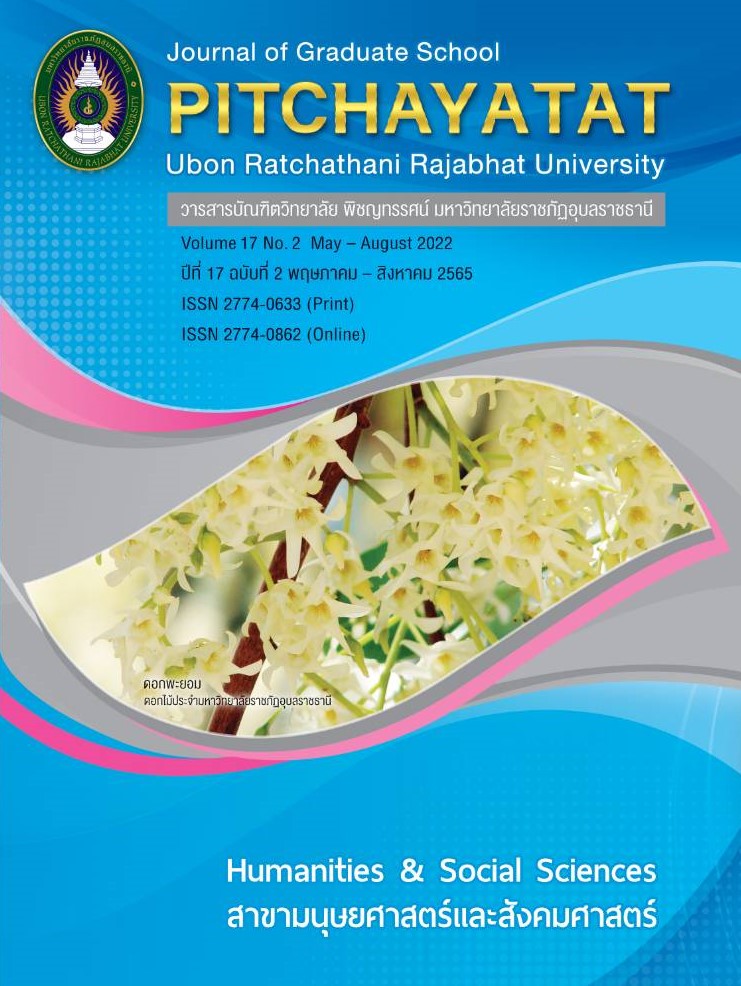ทักษะการบริหารงานในศตวรรษที่ 21 ของผู้บริหารสถานศึกษา ตามการรับรู้ของครู สังกัดสำนักงานเขตพื้นที่การศึกษาประถมศึกษาศรีสะเกษ เขต 3
คำสำคัญ:
ทักษะการบริหารงาน , การรับรู้ของครู , สำนักงานเขตพื้นที่การศึกษาประถมศึกษาศรีสะเกษ เขต 3บทคัดย่อ
การวิจัยนี้มีวัตถุประสงค์ เพื่อศึกษาทักษะและเปรียบเทียบทักษะการบริหารงานในศตวรรษที่ 21 ของผู้บริหารสถานศึกษา ตามการรับรู้ของครู สังกัดสำนักงานเขตพื้นที่การศึกษาประถมศึกษาศรีสะเกษ เขต 3 จำแนกตาม วุฒิการศึกษา ประสบการณ์ทำงาน และขนาดของโรงเรียน ตัวอย่างที่ใช้ ได้แก่ ครูผู้สอน สังกัดสำนักงานเขตพื้นที่การศึกษาประถมศึกษาศรีสะเกษ เขต 3 จำนวน 320 คน โดยใช้วิธีกำหนดขนาดของตัวอย่างจากตารางสำเร็จรูปกำหนดขนาดตัวอย่างของเครจซีและมอร์แกน ตามสัดส่วนที่กำหนดไว้ เครื่องมือที่ใช้ในการรวบรวมข้อมูลเป็นแบบสอบถามมาตราส่วนประมาณค่า 5 ระดับ และแบบสอบถามปลายเปิด ค่าความเชื่อมั่นของแบบสอบถามเท่ากับ .944 สถิติที่ใช้ได้แก่ ร้อยละ ค่าเฉลี่ย ส่วนเบี่ยงเบนมาตรฐาน ในการเปรียบเทียบความแตกต่างระหว่างตัวแปร ใช้สถิติการวิเคราะห์ การทดสอบที การทดสอบเอฟ และการทดสอบความแตกต่างรายคู่ด้วยวิธีการของ Scheffé's
ผลการวิจัยพบว่า
- ทักษะของผู้บริหารสถานศึกษาในศตวรรษที่ 21 สังกัดสำนักงานเขตพื้นที่การศึกษาประถมศึกษาศรีสะเกษ เขต 3 พบว่า โดยภาพรวมและรายด้านอยู่ในระดับมาก
- ผลการเปรียบเทียบทักษะของผู้บริหารสถานศึกษาในศตวรรษที่ 21 สังกัดสำนักงานเขตพื้นที่การศึกษาประถมศึกษาศรีสะเกษ เขต 3 จำแนกตามวุฒิการศึกษา พบว่า ด้านทักษะการบริหารจัดการองค์การ ด้านทักษะการสื่อสาร ด้านทักษะด้านมนุษยสัมพันธ์ มีความแตกต่างกันอย่างมีนัยสำคัญทางสถิติที่ระดับ .01 และด้านทักษะทางมนุษย์ มีความแตกต่างกันอย่างมีนัยสำคัญทางสถิติที่ระดับ .05 จำแนกตามประสบการณ์ทำงาน พบว่ามีความแตกต่างกันที่ระดับ .05 วิเคราะห์ความแตกต่างรายคู่โดยภาพรวม พบว่า ครูผู้สอนที่มีประสบการณ์ทำงานน้อยกว่า 10 ปี กับครูผู้สอนที่มีประสบการณ์ทำงานตั้งแต่ 10–20 ปี มีความคิดเห็นแตกต่างกัน ด้านทักษะการคิดวิเคราะห์และการคิดสร้างสรรค์ พบว่า ครูผู้สอนที่มีประสบการณ์ทำงานน้อยกว่า 10 ปี กับครูผู้สอนที่มีประสบการณ์ทำงานตั้งแต่ 10–20 ปี และครูผู้สอนที่มีประสบการณ์ทำงานตั้งแต่ 10-20ปี กับครูผู้สอนที่มีประสบการณ์ทำงานมากกว่า 20 ปี มีความคิดเห็นแตกต่างกัน ด้านทักษะทางเทคโนโลยีและการใช้ดิจิทัล พบว่า ครูผู้สอนที่มีประสบการณ์ทำงานน้อยกว่า 10 ปี กับครูผู้สอนที่มีประสบการณ์ทำงานตั้งแต่ 10–20 ปี มีความคิดเห็นแตกต่างกัน จำแนกตามขนาดของโรงเรียน พบว่าทั้ง 3 ขนาดไม่แตกต่างกัน
เอกสารอ้างอิง
กณิษฐา ทองสมุทร. ทักษะการบริหารงานในศตวรรษที่ 21 ของผู้บริหารสถานศึกษาตามการรรับรู้ของครู สังกัดสำนักงานเขตพื้นที่การศึกษาประถมศึกษาสุราษฎร์ธานี เขต 2. การค้นคว้าอิสระครุศาสตร มหาบัณฑิต มหาวิทยาลัยราชภัฏสุราษฎร์ธานี, 2561.
เขตพื้นที่การศึกษาประถมศึกษาศรีสะเกษ เขต 3, สำนักงาน. แผนพัฒนาการศึกษาขั้นพื้นฐาน 5 ปี (ปีงบประมาณ 2563–2567). ศรีสะเกษ: สำนักงานเขตพื้นที่การศึกษาประถมศึกษาศรีสะเกษ เขต 3, 2562.
ชัยยนต์ เพาพาน. ผู้บริหารสถานศึกษายุคใหม่ในศตวรรษที่ 21 ใน การประชุมวิชาการระดับชาติครุศาสตร์ ครั้งที่ 1 การจัดการศึกษาเพื่อพัฒนาท้องถิ่น สู่ประชาคมอาเซียน : ทิศทางใหม่ในศตวรรษที่ 21. กาฬสินธุ์: มหาวิทยาลัยกาฬสินธุ์, 2559.
นริศสรา บุญสอาด. ทักษะในศตวรรษที่ 21 ที่ส่งต่อภาวะผู้นำทางวิชาการของผู้บริหารสถานศึกษา สังกัดสำนักงานเขตพื้นที่การศึกษาประถมศึกษาสมุทรสาคร. วิทยานิพนธ์ศึกษาศาสตรมหาบัณฑิต มหาวิทยาลัยศิลปากร, 2563.
บุญชม ศรีสะอาด. การวิจัยเบื้องต้น. พิมพ์ครั้งที่ 7. กรุงเทพฯ: สุวิริยาสาส์น, 2545.
พรพิมล แก้วอุทัศน์. ทักษะการบริหารในศตวรรษที่ 21 ของผู้บริหารสถานศึกษา สังกัดสำนักงานเขตพื้นที่การศึกษาประถมศึกษาบุรีรัมย์ เขต 3 ตามทัศนะของครู. วิทยานิพนธ์ครุศาตรมหาบัณฑิต มหาวิยาลัยราชภัฏ นคราชสีมา, 2563.
พิสณุ ฟองศรี. การเขียนรายงานวิจัยและวิทยานิพนธ์. กรุงเทพฯ: ด่านสุทธาการพิมพ์, 2553.
แพรดาว สนองผัน. ทักษะของผู้บริหารสถานศึกษาในศตวรรษที่ 21 สังกัดสำนักงานเขตพื้นที่การศึกษาประถมศึกษาอุดรธานี เขต 3. วิทยานิพนธ์ศึกษาศาสตรมหาบัณฑิต มหาวิทยาลัยขอนแก่น, 2557.
มัทนียา พยัฆวรรณ. ทักษะการบริหารสถานศึกษาตามแนวทางการปฏิรูปการศึกษาในศตวรรษที่ 21 ตามการรับรู้ ของครู สังกัดสำนักงานเขตพื้นที่การศึกษามัธยมศึกษา เขต 11 ในจังหวัดชุมพร. การค้นคว้าอิสระครุศาสตรมหาบัณฑิต มหาวิทยาลัยราชภัฏสุราษฎร์ธานี, 2561.
มณฑาทิพย์ นามนุ. ทักษะของผู้บริหารสถานศึกษาในศตรวรรษที่ 21 สังกัดสำนักงานเขตพื้นที่การศึกษาประถมศึกษาปทุมธานี เขต 2. วิทยานิพนธ์ศึกษาศาสตรมหาบัณฑิต มหาวิทยาลัยเทคโนโลยีราชมงคล ธัญบุรี, 2561.
วิจารณ์ พานิช. ศาสตร์และศิลป์ของการสอน. กรุงเทพฯ: จุฬาลงกรณ์มหาวิทยาลัย, 2560.
ศศิตา เพลินจิต. ทักษะการบริหารในศตวรรษที่ 21 ของผู้บริหารสถานศึกษาขั้นพื้นฐาน สังกัดสำนักงานเขตพื้นที่การศึกษาประถมศึกษานครปฐม เขต 1. วิทยานิพนธ์ครุศาสตรมหาบัณฑิต มหาวิทยาลัยราชภัฏกาญจนบุรี, 2558.
สมหมาย อ่ำดอนกลอย. “บทบาทผู้บริหารสถานศึกษาในศตวรรษที่ 21,” บัณฑิตศึกษามหาวิทยาลัยราชภัฏพิบูลสงคราม. 7, 1 (กรกฎาคม 2556): 1–7.
สุฑาทิพย์ รุทธิฤทธิ์. การศึกษาความสัมพันธ์ระหว่างองค์ประกอบความฉลาดทางอารมณ์กับทักษะการบริหารงานของผู้บริหารโรงเรียนมัธยมศึกษาส่วนกลาง สังกัดกรมสามัญศึกษา. ปริญญานิพนธ์การศึกษามหาบัณฑิต มหาวิทยาลัยศรีนครินทรวิโรฒ, 2546.
Krejcie, R. V. and D. W. Morgan. “Determining Sample Size for Research Activities,” Educational and Psychological Measurement. 30, 3 (October 1970): 607-610.
ดาวน์โหลด
เผยแพร่แล้ว
รูปแบบการอ้างอิง
ฉบับ
ประเภทบทความ
สัญญาอนุญาต
ลิขสิทธิ์ (c) 2022 วารสารบัณฑิตวิทยาลัย พิชญทรรศน์ มหาวิทยาลัยราชภัฏอุบลราชธานี

อนุญาตภายใต้เงื่อนไข Creative Commons Attribution-NonCommercial-NoDerivatives 4.0 International License.
บทความทุกเรื่องได้รับการตรวจความถูกต้องทางวิชาการโดยผู้ทรงคุณวุฒิภายนอกอย่างน้อย 3 คน ความคิดเห็นในวารสารพิชญทรรศน์เป็นความคิดเห็นของผู้นิพนธ์มิใช่ความคิดเห็นของผู้จัดทำ จึงมิใช่ความรับผิดชอบของวารสารพิชญทรรศน์ และบทความในวารสารพิชญทรรศน์สงวนสิทธิ์ตามกฎหมายไทย การจะนำไปเผยแพร่ต้องได้รับอนุญาตเป็นลายลักษณ์อักษรจากกองบรรณาธิการ






